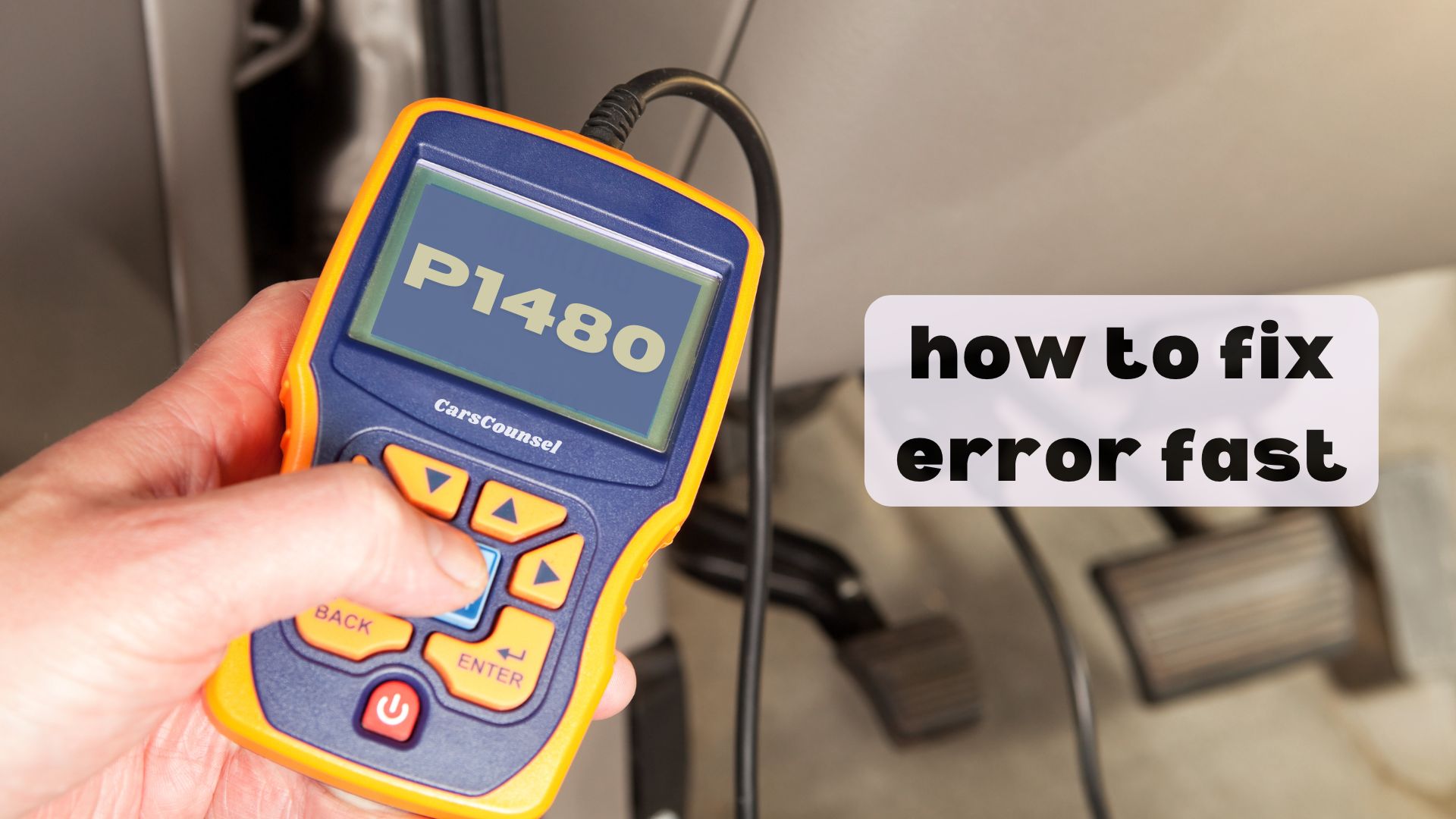When your dashboard lights up with a check engine warning, and the scanner reveals a P1480 code, it’s likely your cooling fan 1 control circuit is malfunctioning, causing the fan to run excessively or not at all. For instance, if your 2015 Honda Civic’s temperature gauge starts to climb on a hot summer day, and the cooling fan doesn’t kick in, you might be staring at a P1480 code. But what’s behind this code, and how do you fix it before engine damage sets in?

Quick Navigation
Key Takeaways
- The P1480 code indicates a high voltage condition in the cooling fan 1 control circuit, causing fan malfunction or failure.
- Faulty relay signs include a clicking sound or no cooling fan noise when the engine is hot, and can lead to engine overheating.
- Common causes include a faulty cooling fan relay, motor, wiring harness, or engine coolant temperature sensor, which must be inspected and replaced if necessary.
- Symptoms of P1480 include engine overheating, AC malfunction, check engine light illumination, and reduced fuel efficiency.
- To fix P1480, scan the vehicle’s onboard computer, inspect and replace faulty components, and clear the trouble code to reset the check engine light.
Code P1480 Description
The diagnostic trouble code P1480 indicates a problem with the cooling fan 1 control circuit being too high, which can lead to issues with the fan’s operation.
This high voltage condition can cause the fan to malfunction or not function at all, resulting in engine overheating. You may notice faulty relay signs, such as a clicking sound or no cooling fan noise when the engine is hot.
If the fan isn’t working correctly, your engine may reach higher temperatures than normal, leading to potential damage. It’s essential to address this issue promptly to prevent further problems.
Common Causes of P1480
When your vehicle’s cooling fan 1 control circuit is experiencing a high voltage condition, as indicated by the P1480 code, it’s often due to a faulty component or malfunctioning system.
This can lead to issues with the fan not functioning properly or at all.
Common causes of P1480 include:
| Component | Faulty Signs | Tests |
|---|---|---|
| Cooling Fan Relay | No power to the fan, faulty relay clicks, or burning smell | Check for corrosion, replace if necessary |
| Cooling Fan Motor | Fan not spinning, excessive noise, or overheating | Inspect for worn or damaged bearings |
| Wiring Harness | Corroded or damaged wires, fan not receiving power | Perform wiring harness tests, repair or replace if needed |
| Engine Coolant Temperature Sensor | Incorrect temperature readings, fan not turning on | Check sensor readings, replace if faulty |
Symptoms of P1480
If your vehicle’s cooling fan 1 control circuit is malfunctioning due to a high voltage condition, you’ll likely notice some telltale signs.
The most obvious symptom is engine overheating, which can lead to serious damage if left unchecked. You may also notice that your air conditioning isn’t working properly.
The check engine light will likely illuminate on your dashboard, indicating a problem. Additionally, you might experience reduced fuel efficiency as your engine works harder to maintain ideal temperatures.
Fan failure can significantly impact engine performance, so it’s essential to address these symptoms promptly to avoid further complications.
How to Fix P1480
Your P1480 code diagnosis begins with a thorough scan of the vehicle’s onboard computer system to retrieve the specific trouble code and pinpoint the exact cause of the problem.
Next, you’ll need to inspect the cooling fan components, including the relay, motor, wiring harness, and temperature sensor, for signs of damage or malfunction.
Replace any faulty parts with new ones to restore proper functionality.
Clear the trouble code from the vehicle’s computer system to reset the check engine light.
If you’re not comfortable with Fan Troubleshooting and Cooling Diagnosis, consider consulting a professional mechanic for assistance.
Understanding Cooling Fan Operation
Now that you’ve identified and addressed the issues causing the P1480 code, it’s time to understand how the cooling fan operates to prevent similar problems in the future. The cooling fan’s design plays a vital role in maintaining ideal engine temperature. Understanding fan motor types is essential to diagnose and repair issues.
| Fan Motor Type | Voltage | Speed Control |
|---|---|---|
| Brushed DC Motor | 12V | PWM (Pulse Width Modulation) |
| Brushless DC Motor | 12V | PWM (Pulse Width Modulation) |
| AC Induction Motor | 120V | Fixed Speed |
Knowing how your cooling fan operates will help you identify potential issues and prevent future problems.
Cooling Fan 1 Control Circuit Function
The Cooling Fan 1 control circuit plays a vital role in regulating the operation of the cooling fan, ensuring the engine maintains a peak operating temperature.
You’ll find that this circuit adjusts the fan speed according to the engine’s cooling requirements. It’s responsible for managing the electrical load on the fan motor, ensuring it operates within a safe and efficient range.
High Voltage Condition Consequences
When the Cooling Fan 1 control circuit experiences a high voltage condition, it can have severe consequences on the engine’s operation. This can lead to voltage regulation issues, causing the fan to malfunction or even fail. As a result, the engine may overheat, reducing its overall performance and efficiency.
| Consequence | Effect on Engine Operation |
|---|---|
| Overheating | Reduced engine performance and efficiency |
| Increased Fuel Consumption | Higher fuel costs and emissions |
| Decreased Fan Efficiency | Reduced airflow and cooling capacity |
| Voltage Regulation Issues | Unstable fan operation and potential failure |
| Premature Engine Wear | Shortened engine lifespan and increased maintenance costs |
Cooling Fan Relay Inspection
Inspecting the cooling fan relay is a crucial step in diagnosing the P1480 code, as a faulty relay can prevent the cooling fan from receiving the necessary signal to turn on.
You’ll want to look for faulty relay signs, such as corrosion, burned or melted components, or a relay that’s stuck in the on or off position.
When replacing the relay, make sure to purchase one that matches the original specifications. Follow the manufacturer’s instructions for installation, and guarantee all electrical connections are secure.
Proper relay replacement tips include verifying the relay’s voltage rating and avoiding overheating during installation.
Engine Coolant Temperature Sensor Check
Faulty engine coolant temperature sensors can mislead the engine control unit, causing issues with the cooling fan operation and triggering a P1480 code.
You’ll need to inspect the sensor for signs of sensor failure, such as corrosion or physical damage. Use a multimeter to check the sensor’s resistance and voltage output. Compare the readings to the manufacturer’s specifications to identify any anomalies.
Temperature fluctuation can also indicate a faulty sensor. If you find any issues, replace the sensor with a new one to certify accurate temperature readings and proper cooling fan operation, thereby guaranteeing reliable performance.
Resetting the Check Engine Light
You’ve diagnosed and repaired the issue causing the P1480 code, and now it’s time to reset the check engine light on your dashboard. This is a vital step to confirm your vehicle’s onboard computer system recognizes the repair and returns to normal engine performance.
| Step | Action | Result |
|---|---|---|
| 1 | Connect a diagnostic scanner | Retrieve trouble code P1480 |
| 2 | Clear the trouble code | Reset check engine light |
| 3 | Test drive the vehicle | Verify engine performance |
| 4 | Monitor the dashboard | Certify the light remains off |
More OBD-II Codes
| P1481 | P1482 | P1483 | P1484 |
| P1485 | P1486 | P1291 | P1292 |
| P1293 | P1294 | P1226 | P1209 |
| P1210 | P1204 | P1202 | P1203 |
| P1198 | P1146 | P1145 | P1144 |
| P1143 | P1142 | P1140 | P1139 |
Frequently Asked Questions
Can I Drive My Car With a P1480 Code?
You can drive your car with caution, but be aware of daily driving conditions, as extreme temperatures or heavy road conditions may exacerbate the issue, leading to further damage or overheating, so monitor your temperature gauge closely.
Will a P1480 Code Cause Long-Term Engine Damage?
If you’re driving with a faulty cooling fan, you’re risking long-term engine damage from excessive overheating. Fan failure can lead to catastrophic engine failure, so it’s vital to address the issue promptly to prevent costly repairs down the road.
Is It Safe to Reset the Code Without Fixing the Issue?
You shouldn’t reset the code without fixing the issue, as it may mask underlying problems like faulty wiring or electrical surges that can cause further damage, leading to engine overheating, decreased performance, and potentially costly repairs.
Can a Faulty Cooling Fan Cause Other Engine Problems?
Oh, sure, just ignore the faulty fan and let your engine turn into a ticking time bomb! But seriously, yes, a faulty cooling fan can cause other engine problems, like overheating risks, which can lead to catastrophic damage, so don’t delay fixing it!
Will a Tune-Up Fix a P1480 Code?
You’re wondering if a tune-up will fix a P1480 code. Unfortunately, a standard tune-up won’t address the root cause, which could be a faulty relay or electrical surge affecting the cooling fan control circuit, requiring more specific repairs.
Conclusion
You’ve finally diagnosed and fixed the P1480 code, but are you wondering if you’ve really gotten to the root of the problem? After all, a faulty cooling fan can be just a symptom of a larger issue. Be sure to regularly inspect your cooling system to prevent future problems. By staying on top of maintenance, you’ll avoid costly repairs and guarantee your engine runs smoothly for years to come.

